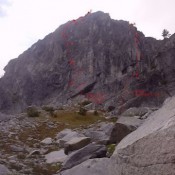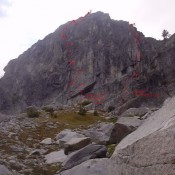Elevation: 8,310 ft
Prominence: 1,286
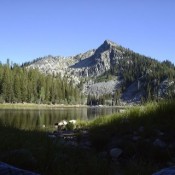
Climbing and access information for this peak is on Page 114 of the book. Michael Stoger and his climbing partners put up many new routes on this peak’s North Face between 2002 and 2004. Thanks to Mike, these routes are documented below.
Jughandle Mountain is probably the most popular summit in the Western Salmon River Mountains. Its popularity is due to several factors. First, it is easily accessed from McCall, Idaho. Second, its North Face is composed of solid granite. Third, Winter access is excellent. There are 2 trip reports by John Platt linked below: one for a Summer ascent and one for a Winter ascent. USGS Paddy Flat
Technical North Face Climbs
1) North Face Routes,
2) 2002 Climbs Michael Stoger and Jeff Smith,
3) 2003 CLIMBS BY Michael Stoger and MikeTeschner,
4) 2004 Climbs.
1) North Face Routes
Michael Stoger and Jeff Smith placed 3 new climbs up the North Face of Jughandle Mountain during July 2002. In 2003, Michael place another route on the face, this time with Mike Teschner. Below is a little general information on the peak. Click below for specifics. Jughandle’s North Wall is about 600 feet tall and consists of very good granite. See photos below. Mike reports the climbs as follows:
Access: To reach the peak’s North Face, hike to Louie Lake [(B)(4)(a) on Page 138] and then follow the trail on the left side of the lake until you reach the South End of the lake. From the South End of the lake, hike to a small boulder field and then scramble up a grassy ramp which follows along a 30-foot cliff until you reach the top of the next “level.” From this point, cross a large boulder field to the base of the North Face. It takes about an hour to reach the base of the wall from the lake. The area in front of the wall offers several walls of very good rock ranging from 50 feet to 100 feet. All photos on this page are Copyright Michael Stoger (2002).
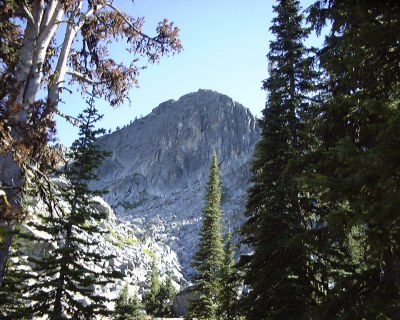
The North Face of Jughandle Mountain.
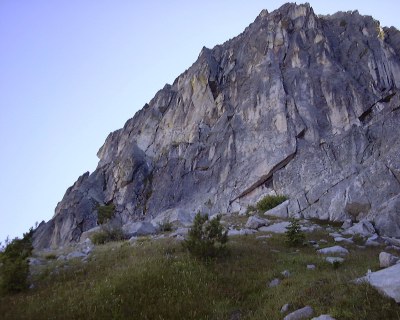
A closer view of the North Face.
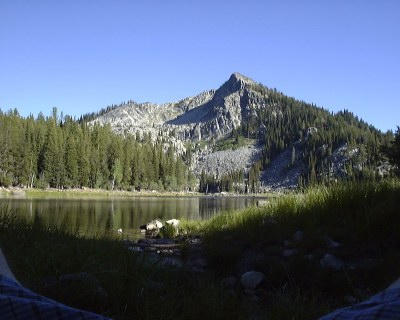
The North Face as viewed from the lake.
2) 2002 CLIMBS by Michael Stoger and Jeff Smith
The first line we put up is the “North East Face”; 4 pitches of 50-55 meters and not harder than 5.10a. The route follows a line of corners and some thinner cracks up the center of the wall. This climb was done clean, ground up; we left no gear behind.
1st pitch (5.10a) climb a smooth, vertical arete just right of a smooth gray slab up to a ledge. Small gear and somewhat run out.
2nd pitch (5.9) climb a ramp to a crack up to a ledge.
3rd pitch (5.10a) climb the vertical finger/hand crack to a ledge.
4th pitch (5.10a) climb a crack straight above the belay ledge to the top.
The second climb is the “North/North East Face”; 5 pitches (5.10d). This climb starts at the prominent great gray slab in the corner of the slab and the vertical wall. It was done ground up as well. We left 2 pitons behind.
1st pitch (5.7); start at a gray slab by a big rock and climb up to a ledge. Belay at a small cave-like roof.
2nd pitch (5.10b); climb the thin vertical face/crack to a fixed piton. A short traverse to the left and straight up to a ledge.
3rd pitch (5.9); climb the corner with little protection to the next ledge. A good belay spot is at some big boulders on the ledge.
4th pitch (5.10d); climb the face straight above the belay protected by 1 fixed pin. The pitch follows a line of flakes and small ramps to a ledge.
5th pitch (5.10); several options to climb to the summit. We climbed the most promising line up a finger crack. Traversing slightly left to a small overhang to gain the summit.
This route is a bit more challenging to protect and the crux pitch is somewhat committing. Getting down is easy too. The climbs top out on the ridge. The ridge is solid and you can place a good anchor anywhere. You can walk off either side and return to the base of the wall.
The third route, Dream Catcher, climbs a steep short wall at the far right side of the wall.
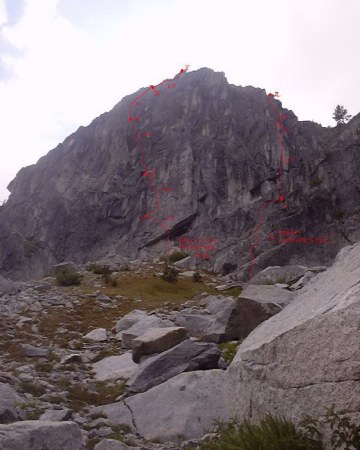
2002 route lines.
1st pitch; climb easy very good granite 5.6 up to the big ramp. You can 4th Class up the ramp and skip the first pitch too.
2nd pitch; climb a very steep, thin crack system, very committing, to a tree anchor. 2 pins are left in the pitch. 5.12d/13a.
3rd pitch; climb from the tree belay up a steep corner and follow the obvious arete to the top. 5.10+.
More information on Dreamcatcher: This weekend, Mike Teschner and I climbed my last year’s route Dream Catcher. This climb has not seen much attention since I put it up solo in 2002. We climbed the wall beginning from the big ramp in 3 pitches instead of
2. If you climb as a 2-person party, it makes more sense this way. I added 2 bolts to the 5.13 crux pitch to prevent people from falling onto the micro stoppers and getting hurt up there. We also added one bolt and one piton to protect the 5.11b face section. During my solo ascent, I rated this part 5.10+; turns out that it is 5.11b.
First pitch; easy scramble up to the ledge system, 5.6.
Second pitch; very difficult thin face with 2 bolts to a run-out thin crack
protected by a piton to finger locks and lay backs. Very sustained small to
medium stoppers and up to #3 TCU’s, 5.13a.
Third pitch; a short vertical thin hands, wide finger crack at 5.10+ #3 and
up TCU’s, up to a small belay ledge at the sharp arête, one fixed piton at
the belay.
Fourth pitch; a short blank face and arete at 5.11b, one bolt, to a sharp
white arête to the top.
Here is the topo of the route: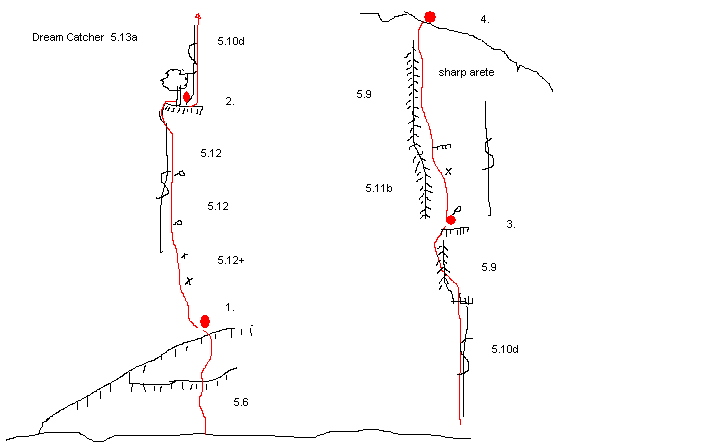
3) 2003 CLIMBS by Michael Stoger and Mike Teschner
All information and photos below provided by Michael Stoger. All photos on this page Copyright Michael Stoger (2003).
“Wall of the Oceanman” 5.13b. Jughandle Mountain North Face, Salmon River
Mountains Idaho.
First ascent: Mike Stoger and Mike Teschner; August 10, 16, and 17.
Here are some details and pictures of this new climb.
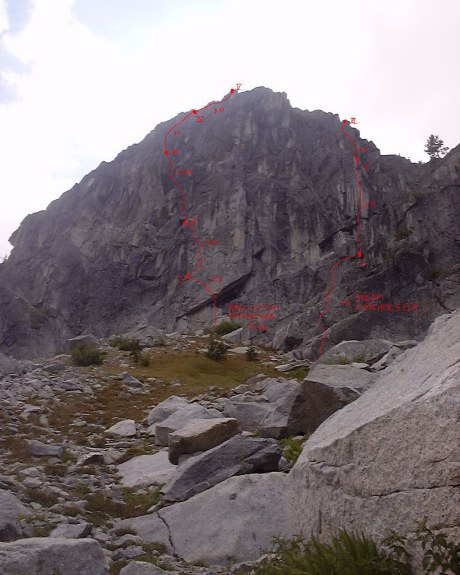
2003 climbs.
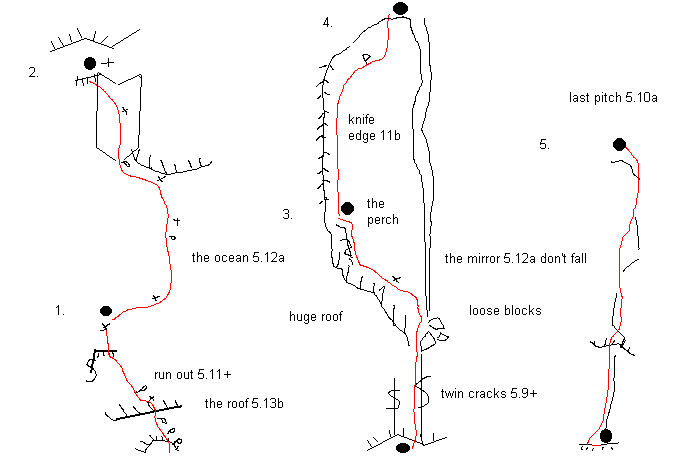
The idea of climbing a direct line through the North Face of Jughandle Mountain started in August 2002. After I finished the 3-pitch “Dream Catcher” (5.7, 5.13a, 5.10). A line starting directly under the big roof fascinated me. In August 2002, I started the line up to the roof. Using a knife blade and the smallest Metolius Astro Nuts, I managed to reach the roof but only to realize that, without some bolts, this line would not be possible.
August 10, 2003. Mike Teschner and I started to work on the first pitch. I added one bolt at the roof, just in reach for the drill. One short Lost Arrow protects the thin 5.11+ face following the roof up to the first belay. Protection: 1 bolt and 4 pitons.
August 16. Mike Teschner and I start up the wall again. This time, I managed to work out the crux roof of the first pitch 5.13b and lead the very run-out 5.11 face following the roof with just the short Lost Arrow. I start out on the second pitch. A vertical granite face with no cracks or places for natural gear. I did not use any sky hooks on all of the pitches. Whenever I was able to place a knife blade, I did so and replaced it with a bolt. The second pitch is fantastic, continuous 5.11 climbing and a 5.11+ traverse adds up to an overall 5.12a rating. The protection is far enough apart that
you have to climb 5.11+ between the protection. Protection: 4 bolts and 2 pitons.
The third pitch started out with some good cracks and quickly turned into a dirty, loose wide crack with no good way out passing a huge roof to the left. The only good looking rock was a smooth wall directly above the gigantic roof on the left, but no protection possible for 20 feet. I place a piton and retreated from the third pitch. Mike and I were both frozen.
August 17. I start out climbing the first pitch and the second pitch. In my mind, I have already made up a plan to climb the smooth face leading out of the dirty section on the third pitch. I hand-drilled a bolt as far into the smooth face as I could reach and went out for the traverse. The face is totally blank except for some small footholds. Once you leave the protection and commit to the next move, there is no turning back. You have to inch your way across the face until you reach the rounded crack. A fall from the 5.12a crux section is not a good idea. After you’ve climbed the crux, a short crack and hand traverse leads to a very exposed belay (the perch), right at the top of the huge roof on a knife-edged arête. I built a belay by hand drilling a bolt and using a short knife blade. The fourth pitch follows the exposed, knife-edged arête. A thin crack protects well with small TSU’s at 5.11b. Follow the knife-edged arete until a knife blade marks a short right traverse to the top of the gigantic pillar. Pitch number five is the last pitch of the North East Face and is a 5.9 or 5.10 crack. We used the least amount of fixed gear possible. 5 pitches with 9 bolts (3 at belays) and 6 pitons. No sky hooks used to place the protection.
First pitch (5.13b); start at the cave under the prominent roof. A 5.11+ start leads to a 5-foot roof with one bolt at the lip. Pull the roof at 5.13b and climb past a fixed pin to the anchor, 5.11+, very run out.
Second (5.12a); start traversing right, clip a bolt and crimp up a technical face including a difficult traverse to a belay underneath a small triangle roof. 5.11+ sections need to be climbed well above the last protection. 4 bolts one Lost Arrow Piton.
Third pitch (5.12a); start climbing the twin cracks from the belay up to a 15-foot loose dirty section just right of the huge roof in the middle of the wall (5.9+). Step left onto a just less than vertical face, clip a bolt and climb left towards a crack. Very exposed 5.12a thin face, do not fall at the crux (potential danger). Once you’ve reached the crack, climb up and left onto a small ledge super exposed at the tip of the huge roof and a knife-edged arete.
Fourth pitch (5.11b); from the very exposed belay, follow the knife-edged arete using a thin crack for small stoppers and TSU’S for protection and follow it up until a knife blade marks a traverse to the right and a short climb up to the top of the huge pillar.
Fifth pitch (5.9 or 5.10); is the same as the North East Face. Other variations are possible to reach the top.
We placed 9 bolts for the 5 pitches; 3 of them are belay anchors. We used and left 6 pitons in the wall. I did not use sky hooks for placing protection. I installed all fixed anchors by muscle power. I think I will call the climb “Wall of the Ocean Man”, thinking of my son Andrew. The climb starts 50 feet left of “Dream Catcher” 5.13a.
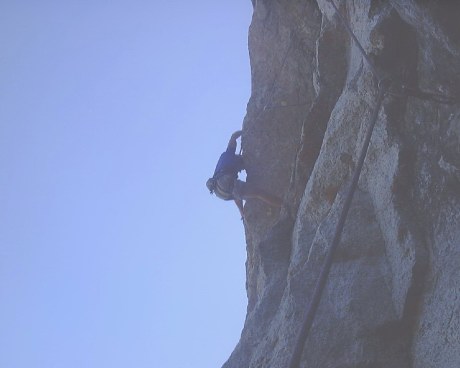
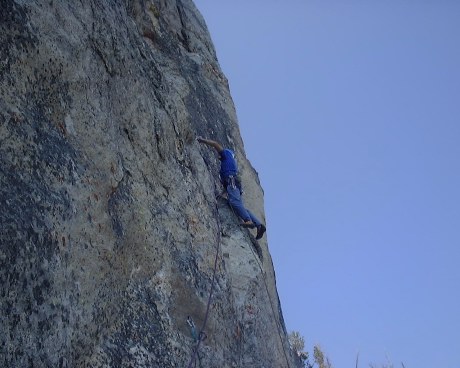
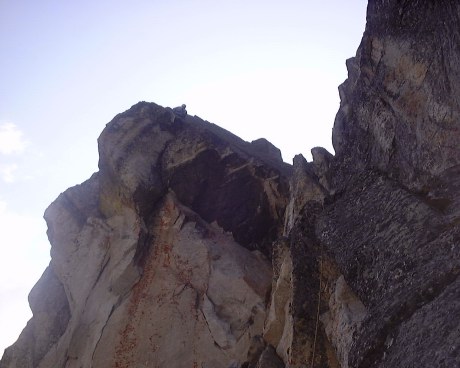
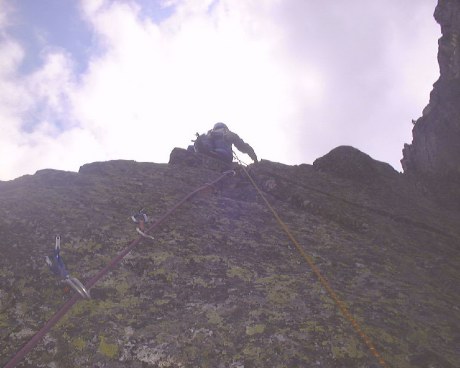
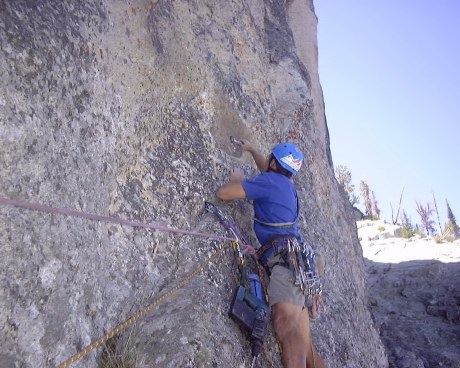
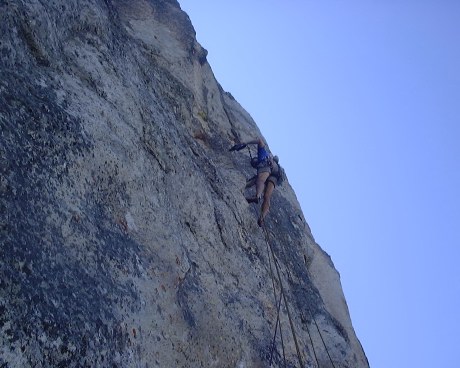
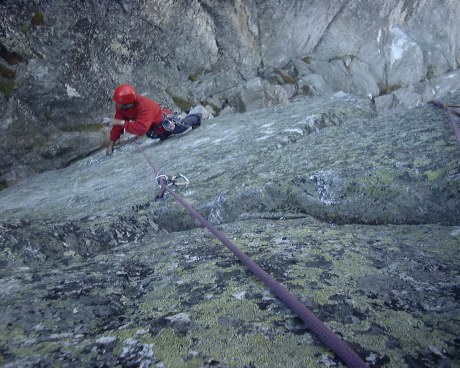
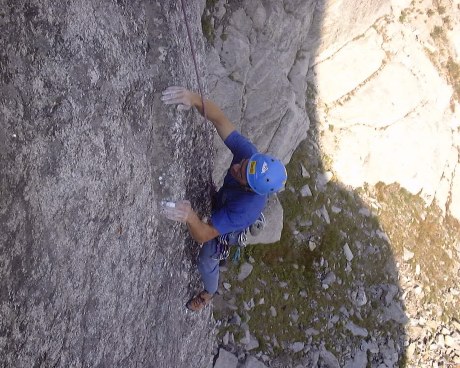
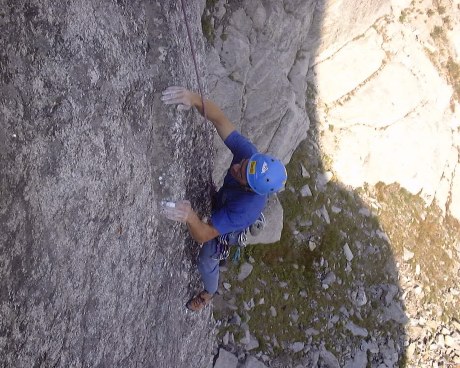
And still more 2003 climbs!
Mike’s comments:
Sean and I put up a new line on the Jughandle Mountain Lower North Face. 3 Pitches starting right of the prominent roof following a steep corner.
First pitch; starts at a short steep crack, traverses left after crack runs out and gains a big ledge (5.10a).
Second pitch; climb the steep corner past a roof (5.10+), continue up the corner and exit via a crux section into easy ground, (5.11 committing and a lot of lichen). From the belay ledge, climb the steep ramp for 30 feet and follow the overhanging crack to the top (5.10).
My wife and I climbed a short 2-pitch line 100 feet to the left. (see
picture). Pitch a short fun finger and hand crack (5.9+) up to a ledge. From the ledge, follow the steep thin crack to the top (5.10b).
One of the pictures is of the crux pitch of Dream Catcher 5.13a R. The other one is the short 5.12a X,R ( direct north face). Still need to add the 3 pitches to the top.
4) 2004 Climbs
Mike Stoger and friends keep putting up new routes on the North Face of Jughandle. Here is Mike’s lastest e-mail.
(1) Renegade:
I was up on Jughandle on Saturday (6/19/04) together with Adam and Brad. We had a true alpine approach with lots of snow. My goal was to finish the “Renegade” and we almost turned around after the first pitch as a hail storm soaked us, the ropes, and the rock. After the sun came back out and dried the rock for most part, we climbed on and finished the route.
The first pitch starts just left of the prominent gully at a one bolt belay. We had to start there because of the amount of snow. Climb the buttress to the ledge using some TCU’S and 2 bolts for protection. Stay right of the wide crack for the best climbing. Belay at the ledge with one bolt and one piton. 5.10c.
The second pitch is the “money pitch”. Climb the double overhang to a ledge. Start out easy up to the large overhang, split by a crack. Place some pro and clip a bolt before you engage into two bad jams and do a full body dyno to a hold at the lip of the overhang. Clip a piton and muscle yourself up onto easier ground. Climb the face to the next overhang. The second overhang goes at 5.12b, 1 bolt and 2 pitons.
The third pitch starts out easy, straight up from the belay until you see a bolt in a vertical slab. Clip this bolt and climb a short 5.10a section to the anchor. Be careful not to fall at the 10a or you will hit the ledge. From the third pitch, it is Class 4 climbing to the top.
The Renegade bypass climbs the dihedral left of the crux pitch at 5.9+. There is an optional starting pitch as well just left of the first pitch.
And yet another route. (2) Brave Like a Girl:
I put in a new climb on Jughandle yesterday together with Adam after starting the first pitch in July. “Brave like a Girl” is climbing the face left of the Wall of the Oceanman (see 2003 climbs) to a ledge under the great yellow overhanging wall. The second pitch climbs the yellow overhang at 120 feet and 40 feet overhanging to the 3 belay of the Oceanman. The third is identical with the Oceanmans’ fourth pitch. The last pitch is bypassing the original gully pitch on the right using the arete.
Pitch 1: 5.11c 4 bolts and small to mid cams.
Pitch 2: 5.13a bolts some small cams.
Pitch 3: 5.11 one pin and small cams.
Pitch 4: 5.10 one bolt one pin.
Additional Resources
Mountain Range: Western Salmon River Mountains
Year Climbed: 2002
